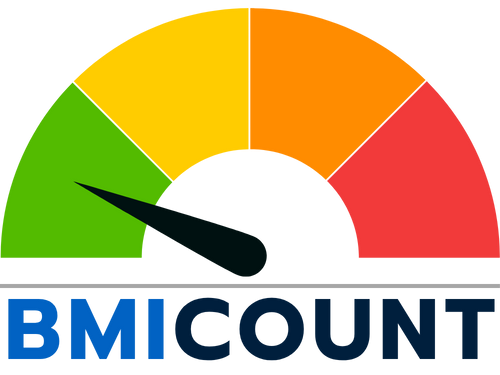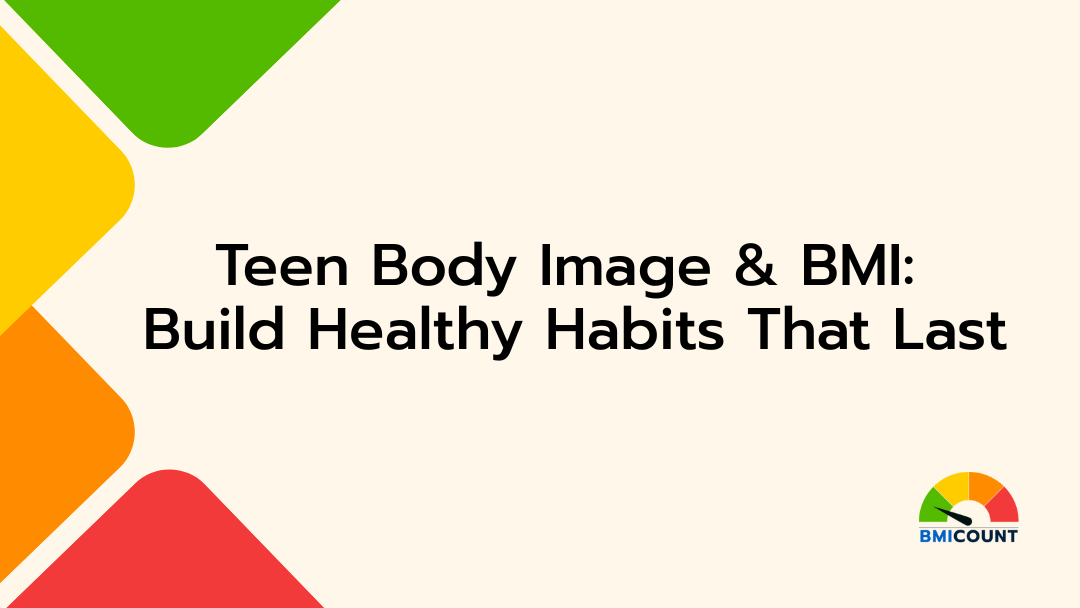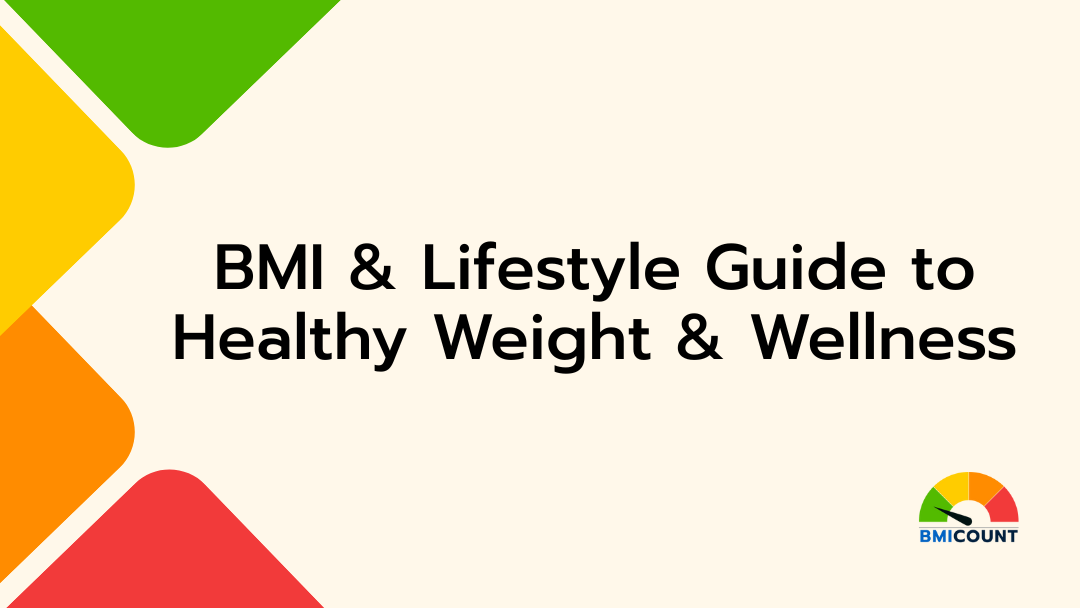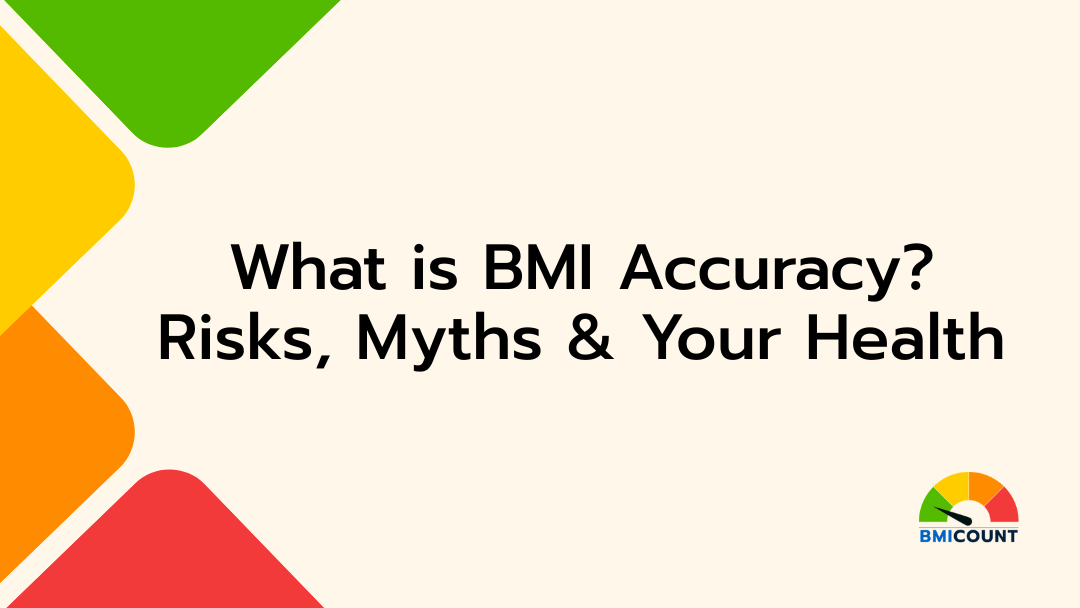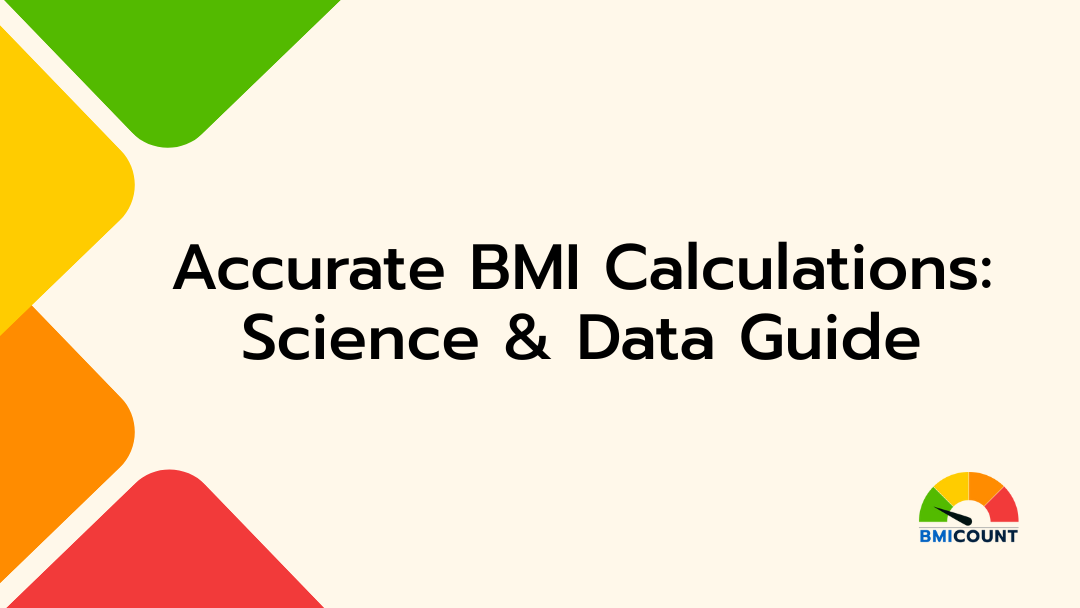Teen Health Is More Than a Number
Teenagers today face a unique health challenge: their bodies are changing fast, but their self-image isn’t always keeping up. Social media, peer pressure, and unrealistic beauty standards have created a culture where teen body image issues are more common, and more harmfu than ever.
At the same time, parents and caregivers want to ensure teens are growing up healthy. That often leads them to tools like BMI (Body Mass Index) a number that compares weight to height to help screen for potential health risks. But here’s the truth: BMI isn’t everything, especially during adolescence.
Puberty causes rapid shifts in weight, height, hormones, and body composition. So rather than using BMI as a standalone judgment, it should be just one part of a broader conversation about sustainable habits, emotional support, and body confidence.
That’s why our Teen BMI Calculator uses age- and sex-specific percentiles, offering a more accurate picture than adult-based tools. It’s a great way to understand trends not label your teen.
For deeper insight, our Complete Guide to BMI breaks down how BMI works, when it matters, and when it doesn’t.
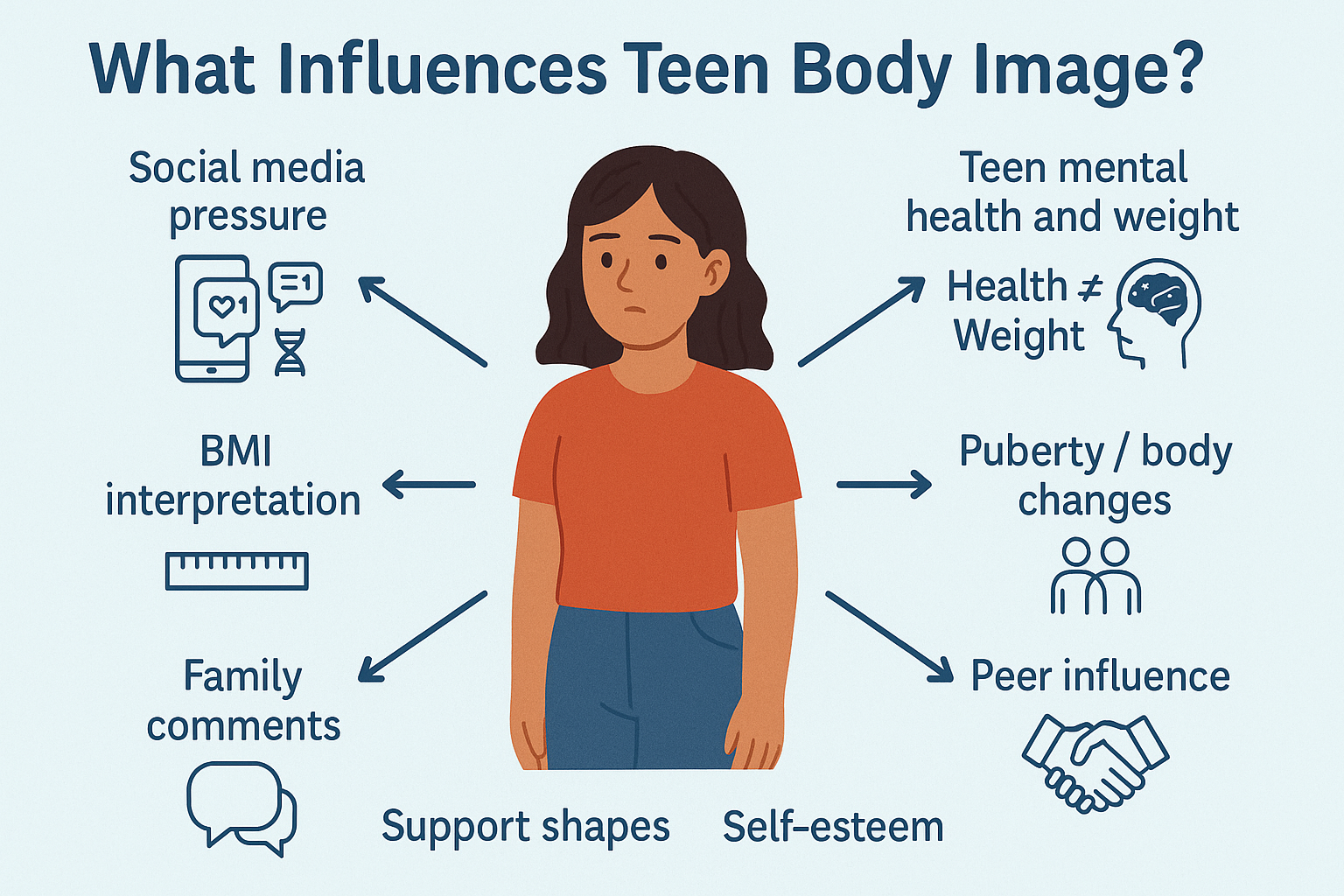
“Teen body image issues aren’t solved by focusing on BMI alone they’re addressed by building confidence, healthy eating habits for teens, and lifelong habits that support growth.”
What Is Teen BMI and How Is It Different?
BMI (Body Mass Index) is a widely used tool for assessing weight relative to height, but BMI for teenagers is calculated and interpreted very differently than for adults. During adolescence, growth happens in spurts. Hormones shift, body fat redistributes, and muscle mass increases often unevenly and unpredictably.
Because of these rapid changes, a teen’s BMI isn’t just about the number itself it’s about how that number compares to others of the same age and sex. This is where BMI percentiles come in.
Our Teen BMI Percentile Calculator evaluates BMI using data from the CDC growth charts, which help determine if your teen is underweight, at a healthy weight, overweight, or obese all relative to where they are in their development journey.
Teen BMI Classification Chart
| BMI Percentile | Category | What It Means |
|---|---|---|
| Below the 5th percentile | Underweight | May indicate a nutritional gap or delayed growth |
| 5th – 85th percentile | Healthy weight | Typical for most adolescents; considered within a normal growth range |
| 85th – 95th percentile | Overweight | May suggest risk for adolescent obesity BMI and should be monitored |
| Above 95th percentile | Obese | Potentially serious; requires lifestyle adjustments and medical guidance |
Why Adult BMI Doesn’t Work for Teens:
❌ It doesn’t factor in age-specific development
❌ It ignores differences in puberty onset between boys and girls
❌ It can misclassify growing teens as “overweight” when they’re building muscle
That’s why tools like the Teen BMI Calculator are built around developmental science not just math.
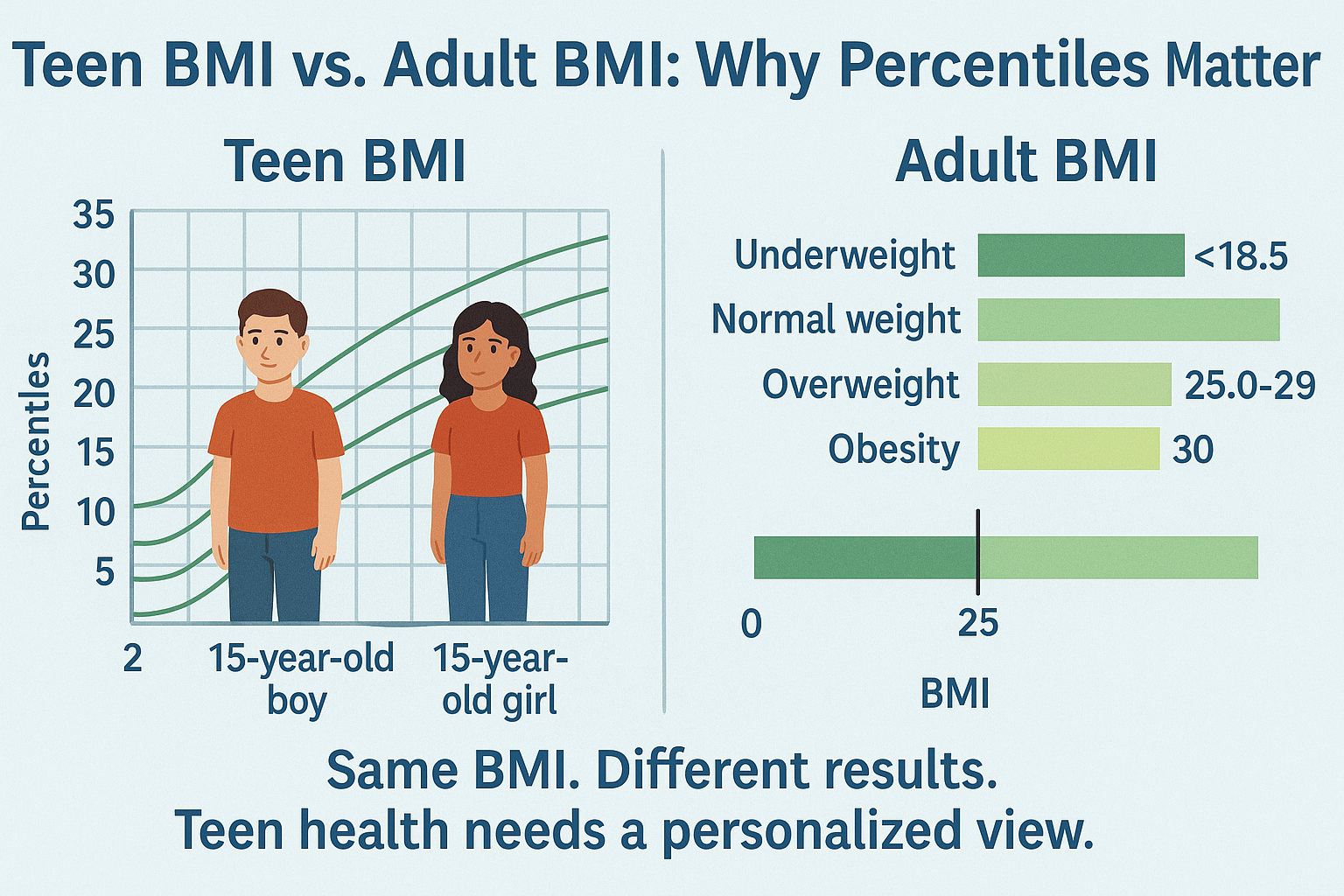
“Teen BMI is best interpreted using percentiles because growth during adolescence is unique, and no single number tells the full health story.”
Body Image & Mental Health in Teens
Adolescence isn’t just a time of physical growth it’s also when self-perception and emotional health become incredibly fragile. Teens are figuring out who they are while trying to fit in, make friends, and meet expectations all while watching a highlight reel of “perfect” bodies on social media.
This combination often leads to teen body image issues and anxiety around weight, shape, or physical appearance regardless of actual health. A teen could fall into a healthy BMI range and still feel like they’re “not enough.”
When self-worth becomes linked to size, it can trigger or worsen:
- Disordered eating patterns
- Depression and anxiety
- Avoidance of physical activity
- Social withdrawal
- Body dysmorphia
This is why teen mental health and weight should always be discussed together. BMI may provide helpful data, but it’s emotional context like how a teen feels about their body that determines long-term well-being.
How Parents and Caregivers Can Help:
🧠 Focus on function, not form – Celebrate what their body can do, not just how it looks
🗣️ Start open, non-judgmental conversations about self-image
📵 Limit screen time or curate body-positive media content
🧍 Avoid commenting on weight or size, even jokingly
🫶 Validate their feelings without trying to “fix” them immediately
✅ Consider using our Teen BMI Calculator to frame the discussion as an exploration of growth, not as a measure of success or failure.
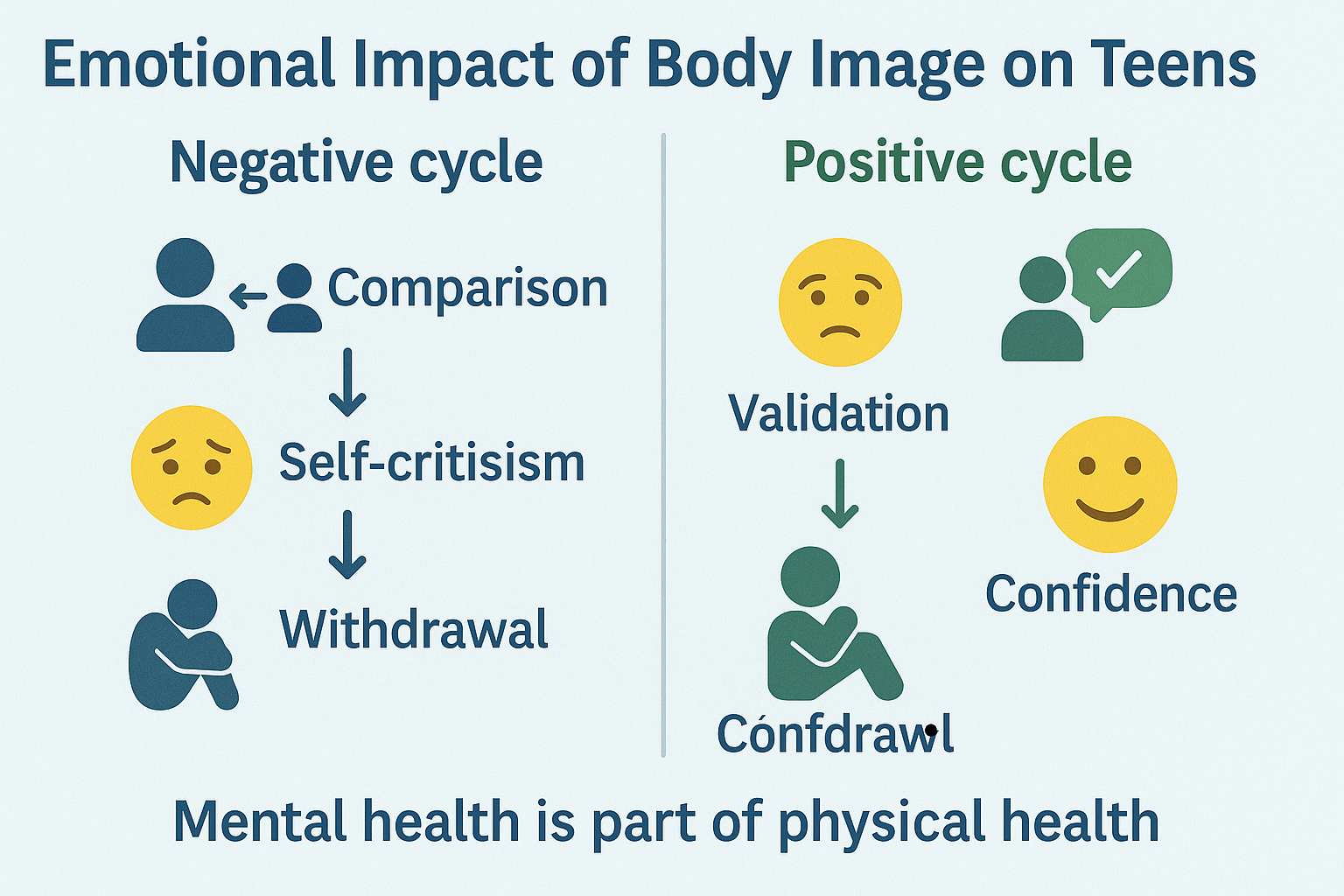
“Teen mental health and weight are deeply connected when we focus on emotional well-being first, we create the foundation for positive body image in teens.”
Healthy Eating Habits for Teens
Nutrition plays a major role in a teenager’s physical development, brain function, energy levels, and emotional well-being. Yet teens are often overwhelmed by conflicting food advice from “clean eating” trends to body-shaming diet culture. That’s why it’s essential to reframe food as fuel and nourishment, not something to fear or restrict.
The goal? Help teens build healthy eating habits that are flexible, enjoyable, and sustainable not restrictive.
What Healthy Eating Habits Looks Like for Teens
| Habit | Why It Matters |
|---|---|
| 🍳 Eat breakfast daily | Boosts concentration, energy, and reduces overeating later in the day |
| 🥦 Eat a variety of foods | Provides essential nutrients for growth and mental clarity |
| 🥤 Stay hydrated | Supports metabolism, energy, skin health, and focus |
| 🧀 Include all food groups | Teens Healthy Eating Habits need protein, healthy fats, carbs, fiber, vitamins no food is “bad” |
| 🍕 Allow for flexibility | Celebrations, cravings, and comfort foods are part of a normal, balanced life |
Avoid:
🚫 Skipping meals or “saving calories”
🚫 Labeling foods as “good” or “bad”
🚫 Following restrictive fads or detox diets
🚫 Using weight loss as motivation for eating “healthy”
Instead, encourage consistency. A teen who eats balanced meals most of the time, enjoys movement, and listens to their hunger and fullness cues is on the right track regardless of the number on a scale or chart.
Need help understanding how growth affects nutrition? Our BMI and Lifestyle Guide breaks it down by age group and activity level.
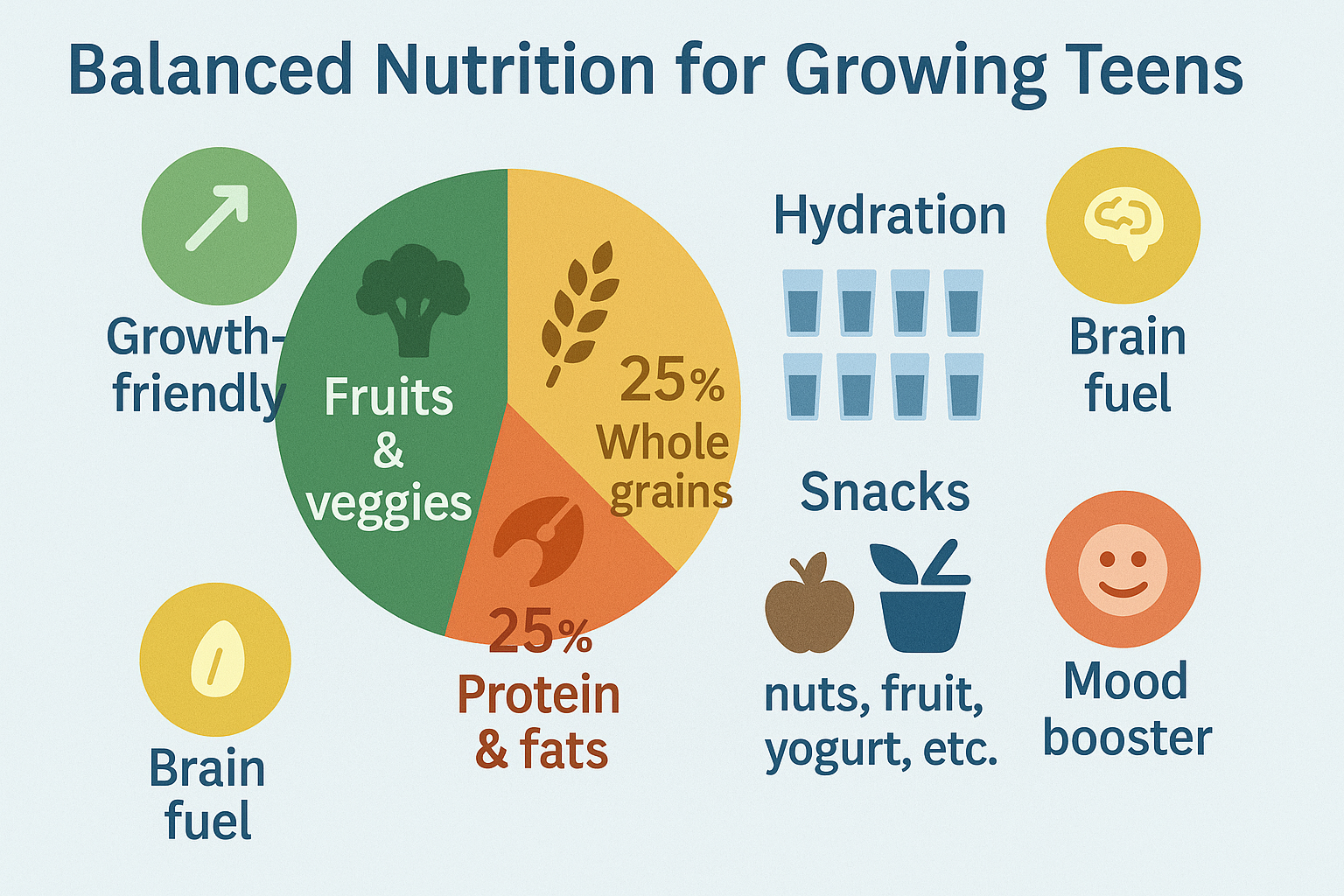
“Healthy eating habits for teens should be built on variety, balance, and self-trust not calorie counting or restrictive rules.”
Exercise for Teenagers – Movement That Builds Confidence
Teenagers need movement not just for physical health, but for mental clarity, stress relief, and emotional balance. Yet many teens are turned off by traditional “fitness” culture, which often focuses on weight loss, athletic performance, or body aesthetics.
Instead, the key is to help teens discover forms of exercise they enjoy and to view movement as a mood booster, not a punishment.
According to the CDC, the physical activity guidelines for teenagers recommend:
- At least 60 minutes of moderate to vigorous activity every day
- Muscle-strengthening activities (like resistance bands or yoga) 3 times per week
- Activities that promote bone health (like jumping, running, or dancing)
Fun & Functional Ways to Stay Active
| Activity | Why Teens Like It |
|---|---|
| 🕺 Dance or TikTok trends | Creative expression + fitness = fun |
| 🎾 Team sports | Builds social confidence and discipline |
| 🚶 Walking or biking | Easy, low-pressure movement + time outdoors |
| 🧘 Yoga or stretching | Calms nerves, improves flexibility, relieves stress |
| 🏋️ Light strength training | Boosts confidence, promotes healthy muscle development |
| 🎮 Active video games | Turns screen time into movement (and it counts!) |
Teens are more likely to stick with activities they enjoy. So instead of forcing gym routines, let them lead. That freedom builds a healthy lifestyle for kids and teens that actually lasts.
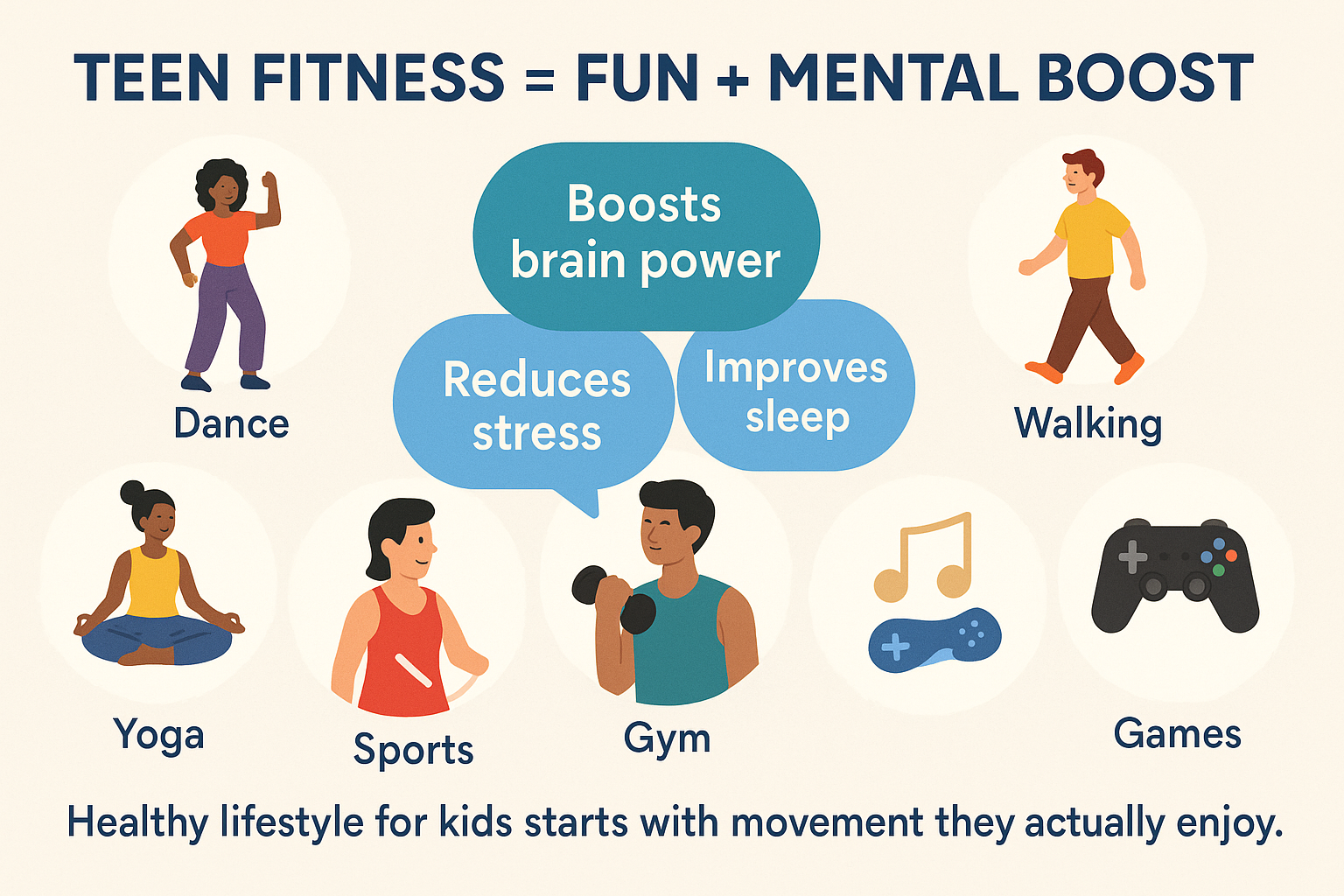
“Exercise for teenagers isn’t about appearance it’s about energy, mood, and confidence. Movement should be a form of self-respect, not self-punishment.”
Creating a Supportive Environment at Home
The habits teens build today will likely follow them into adulthood but they don’t form those habits in isolation. The most powerful influence? Their home environment.
Whether you’re a parent, guardian, or caregiver, your role isn’t to control your Teen Body Image & health decisions it’s to create a safe space where healthy choices feel natural, supported, and sustainable.
Here’s how to do that:
Everyday Ways to Promote a Healthy Lifestyle for Kids and Teens
🍽️ Model balanced meals — Eat together when possible and show variety on your own plate
🧠 Talk about feelings, not just food or weight — Normalize emotional ups and downs
💪 Make movement a family thing — Go for walks, hikes, or dance breaks at home
🎯 Set realistic expectations — Focus on effort, not appearance
🧘 Encourage rest & sleep — Teens need 8–10 hours of quality sleep for recovery and mood
📱 Limit toxic media — Help them curate feeds with diverse, body-positive influences
🔄 Reframe “mistakes” — One off day doesn’t undo progress. Teach bounce-back, not guilt.
Need science to back this up? Our BMI Accuracy, Risks & Misconceptions post explains how overemphasizing numbers can actually harm motivation and emotional well-being.
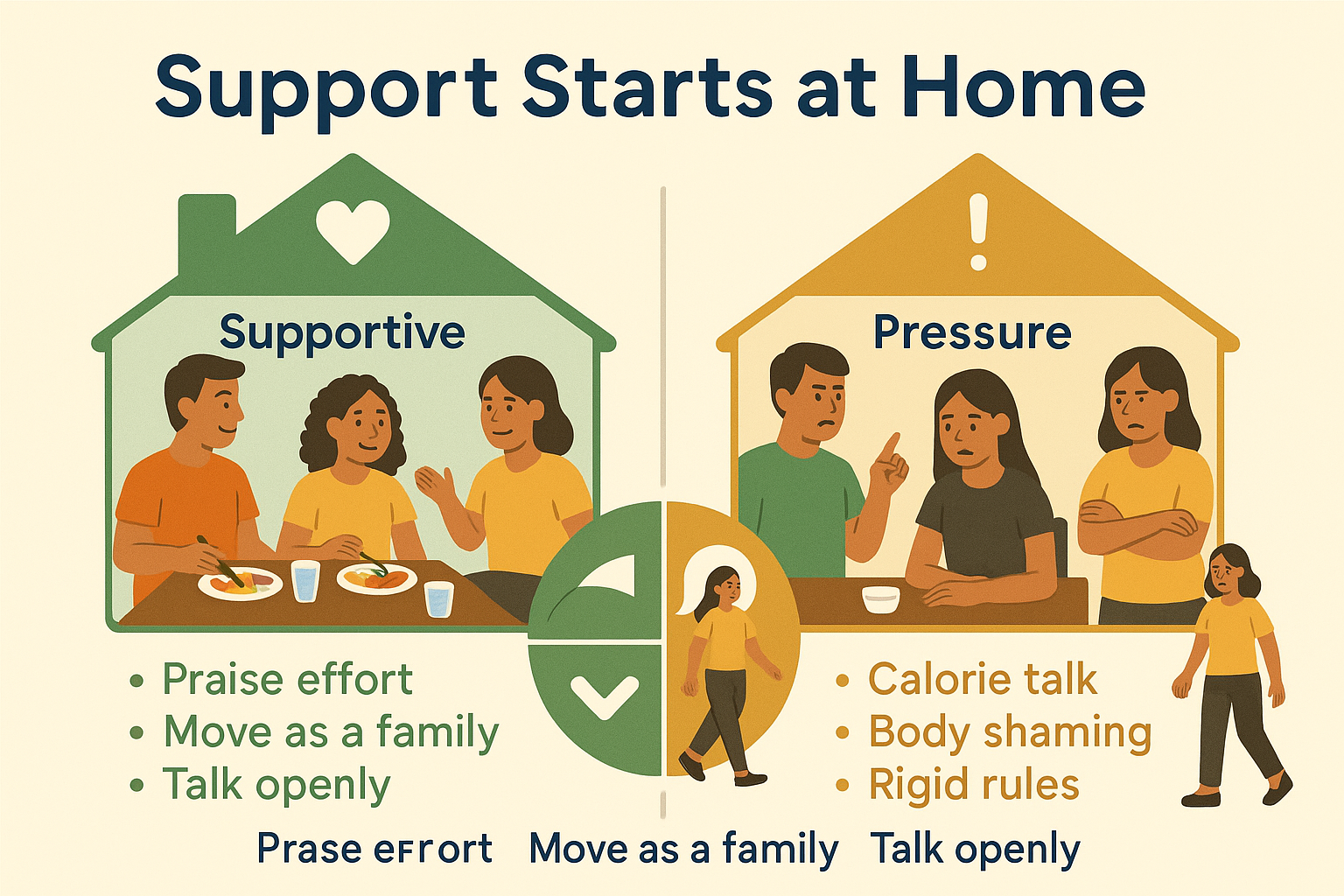
“Healthy lifestyle for kids and teens starts with a supportive home where food is joyful, movement is shared, and every body is respected.”
Explore Other BMI Tools for Every Life Stage
Your Teen Body Image & health journey is unique but they’re not the only ones who benefit from personalized BMI insights. Explore our full suite of tools designed to support every age group:
- BMI Calculator for Kids — Tailored for children aged 2–12 using percentile charts
- BMI Calculator for Women — Includes hormonal factors and female-specific metrics
- BMI Calculator for Men — Built for adult male physiology and activity levels
- BMI Calculator for Seniors — Age-adjusted for those 60+ with bone density and muscle loss in mind
- General BMI Calculator — A quick, universal tool for adult weight classification
All our tools use science-backed data and provide clear, growth-stage-appropriate insights so you can focus less on the number, and more on meaningful change.
Frequently Asked Questions
What is a healthy BMI range for teenagers?
For teens, a healthy BMI is not based on a single number. Instead, it’s determined using percentiles that compare age and sex. Generally, the 5th to 85th percentile is considered healthy.
How can I support positive body image in teens?
Promote body function over appearance, limit negative body talk, and help teens curate body-positive media. Encourage self-kindness and avoid over-focusing on weight.
Why is BMI interpreted differently for teenagers?
Teens go through rapid growth during puberty. BMI for teenagers must be interpreted using age- and sex-specific percentiles, not adult cutoffs. Use our Teen BMI Calculator to check accurately.
How can teens build healthy eating habits?
Start with regular meals, hydration, a variety of food groups, and flexibility. Avoid restrictive diets. Learn more in our BMI and Lifestyle Guide.
What exercises are best for teenagers?
Anything they enjoy! Team sports, dance, walking, yoga, strength training, or active video games all count. The goal is consistency, not perfection.
Can poor body image affect teen mental health?
Yes. Low body confidence can increase anxiety, depression, and disordered eating. Supportive environments help reduce these risks significantly.
Where can I check my teen’s BMI accurately?
You can use our Teen BMI Calculator — it’s based on CDC growth charts and provides percentile-based feedback tailored to teens.
Should I worry if my teen’s BMI is high or low?
Not always. Puberty causes temporary shifts in BMI. Use trends, not single numbers, and speak with a pediatrician before making health assumptions.
